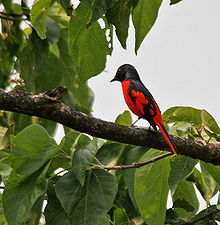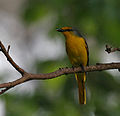- Scarlet Minivet
-
Scarlet Minivet 
Female in Sri Lanka Conservation status Scientific classification Kingdom: Animalia Phylum: Chordata Class: Aves Order: Passeriformes Family: Campephagidae Genus: Pericrocotus Species: P. flammeus Binomial name Pericrocotus flammeus
Forster, 1781The Scarlet Minivet, Pericrocotus flammeus is a small passerine bird. This minivet is found in tropical southern Asia from the Indian subcontinent east to southern China, Indonesia, and the Philippines. They are common resident breeding birds in forests and other well-wooded habitats including gardens, especially in hilly country. While the male is scarlet to orange with black upper parts, the females are usually yellow with greyish olive upper parts. Several former subspecies have been elevated to species status in recent works. These include the Orange Minivet (flammeus in the narrow sense) while the Scarlet Minivet in the restricted sense is used for Pericrocotus speciosus. All subspecies have the same habits of gleaning for insects and are often seen in mixed-species foraging flocks, usually foraging in small groups, high up in the forest canopy.
Contents
Description
The Scarlet Minivet is 20-22 cm long with a strong dark beak and long wings. The male has black upperparts and head, and scarlet underparts, tail edges, rump and wing patches. The shape and colour of the wing patches and the shade or orange in the male varies across populations. The female is grey above, with yellow underparts (including the face), tail edges, rump and wing patches.
Taxonomy and systematics
 Illustration of the Orange Minivet (P. f. flammeus) of the Western Ghats compared with male speciosus (top)
Illustration of the Orange Minivet (P. f. flammeus) of the Western Ghats compared with male speciosus (top)
There is considerable geographic variation in this species and several disjunct populations exist. Some former races are sometimes considered full species requiring the reorganization of other former subspecies. As many as nineteen subspecies have been described. Race speciosus (Latham, 1790) found along the Himalayas from Kashmir east to southern China has been elevated to a full species in some works.[2] If this is considered a species, then the races fraterculus, andamanensis and semiruber would be considered as subspecies of that species. The named subspecies within this complex include:[3]
- speciosus (Latham, 1790) along the Himalayas
- flammeus (J. R. Forster, 1781) Western Ghats, Nilgiris and Sri Lanka (called the Orange Minivet)
- fohkiensis Buturlin, 1910 is found in southeastern China
- flammifer Hume, 1875 is found in southern Myanmar, southern Thailand and Peninsular Malaysia
- xanthogaster (Raffles, 1822) is found in the southern part of Peninsular Malaysia and Sumatra
Several isolated island forms that have been described include:
- minythomelas Oberholser, 1912 is an insular form described from Simeulue Island off Sumatra.
- modiglianii Salvadori, 1892 from Enggano Island
- insulanus Deignan, 1946 from Borneo.
- siebersi Rensch, 1928 from Java and Bali.
- exul Wallace, 1864 from Lombok
- novus McGregor, 1904 from Luzon and Negros
- leytensis Steere, 1890 from Samar, Leyte and Bohol
- gonzalesi Ripley & Rabor, 1961 from N & E Mindanao
- nigroluteus Parkes, 1981 from south central Mindanao
- johnstoniae Ogilvie-Grant, 1905 from Mt. Apo in southeastern Mindanao
- marchesae Guillemard, 1885 from the Sulu Archipelago
Ecology and behaviour
This minivet catches insects in trees by flycatching or while perched. It flushes insects out of foliage by beating its wings hard. Scarlet Minivet will form small flocks. Its song is a pleasant whistling. This bird nests high up in the treetops. The nest is a cup-like structure woven with small twigs and spiders' webs to increase the strength of the nest. Two or three spotted pale green eggs are laid. Incubation is mainly by the female, but both birds help to raise the offspring.
References
- ^ BirdLife International (2004). Pericrocotus flammeus. 2006. IUCN Red List of Threatened Species. IUCN 2006. www.iucnredlist.org. Retrieved on 9 May 2006. Database entry includes justification for why this species is of least concern
- ^ Rasmussen, PC & JC Anderton (2005) Birds of South Asia: The Ripley Guide. Smithsonian Institution & Lynx Edicions. Vol. 2. p. 327
- ^ Dickinson, E.C., R.W.R.J. Dekker, S. Eck & S. Somadikarta (2002) Systematic notes on Asian birds. 23. Types of the Campephagidae. Zool. Verh. Leiden 340:31-74 PDF
External links
-
Male at Jayanti in Buxa Tiger Reserve in Jalpaiguri district of West Bengal, India.
-
Female at Jayanti in Buxa Tiger Reserve in Jalpaiguri district of West Bengal, India.
-
Female at Jayanti in Buxa Tiger Reserve in Jalpaiguri district of West Bengal, India.
-
Male at Jayanti in Buxa Tiger Reserve in Jalpaiguri district of West Bengal, India.
-
Female at Jayanti in Buxa Tiger Reserve in Jalpaiguri district of West Bengal, India.
Categories:- IUCN Red List least concern species
- Pericrocotus
- Birds of Asia
- Birds of Pakistan
- Birds of Southeast Asia
- Birds of Bangladesh
- Birds of Bhutan
- Birds of Brunei
- Birds of Cambodia
- Birds of China
- Birds of India
- Birds of Indonesia
- Birds of Laos
- Birds of Malaysia
- Birds of Burma
- Birds of Nepal
- Birds of the Philippines
- Birds of Singapore
- Birds of Sri Lanka
- Birds of Thailand
- Birds of Vietnam
- Animals described in 1781
Wikimedia Foundation. 2010.







